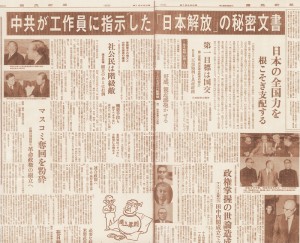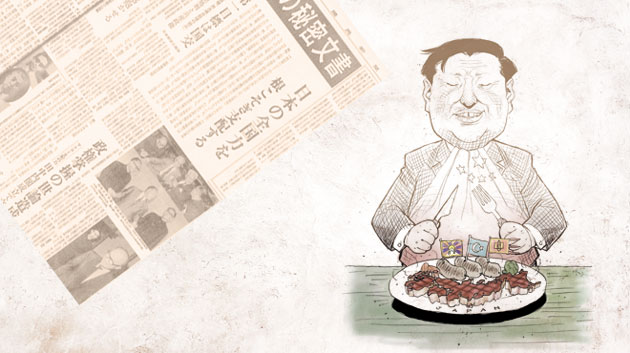The Future of Japan and China – Part 1
China’s intentions of invading Japan have been an object of discussion for a while. Recent trends in Japanese-Chinese relations seem to suggest that China is surely and steadily making progress with its plans. We get a clearer idea of what is happening if we look at places like Uighur and Tibet that have already become autonomous regions of China.
By Norichika Yamashita
The invasion is already happening
China’s “Directive to Liberate Japan”
Inner Mongolia, Uighur, and Tibet. What is next?

On August 5th 1972, the Kokumin Shimbun published an article about the discovery of the “Phase II Operational Directive for the Liberation of Japan”, which is considered a blueprint of the Chinese government’s strategy for invading Japan.
As early as 1972, the existence of a document called “Phase II Operational Directive for the Liberation of Japan” (in this text: “Operational Directive”) was confirmed. In this document, the Communist Party of China detailed its plans and gave orders to its agents to invade Japan.
Tadashi Nishiuchi (1903-1993), Chuo Gakuin University professor and specialist on China, obtained this secret document from an organization (the source of information remains under wraps) while he was doing research in Okinawa, Taiwan, and other places in North East Asia. When he got back to Japan, he published his findings in the newspaper Kokumin Shimbun (Note 1).
The Operational Directive begins with the following words:
“Our Party’s (the Chinese Communist Party’s) basic strategy for the liberation of Japan to be pursued in the near future is to bring all the national authority Japan enjoys at present under the control of our Party, and push forward with our Party’s war to liberate the world.” (Kokumin Shimbun, August 5th, 1972)
It continues as follows:
“We will bring about the peaceful liberation of Japan in the following 3 stages:
Stage 1: Restoring diplomatic relations between China and Japan
Stage 2: Establishing an Allied Democratic Party Government in Japan
Stage 3: Establishing the People’s Democratic Republic of Japan; Holding the Emperor of Japan responsible for war crimes, and executing him (same source).
“I’m planning no such thing”
Zhou Enlai roaring with laughter
At the time Japanese-Chinese diplomatic relations normalized as stated in the Operational Directive, Kakuei Tanaka’s cabinet had been freshly inaugurated. The document exerted a strong influence both in Japan and abroad. Prime Minister Tanaka questioned the relevant authorities about its authenticity, and it was quickly translated into many languages so it could be read in the US, the Soviet Union, Korea, and India.
In China, on the other hand, which was the originator of it all, Premier Zhou Enlai told literary critic Kenzo Nakajima who was visiting from Japan: “I hear a Japanese newspaper published an article about China wanting to liberate Japan but I’m planning no such thing!” and roared with laughter (Kokumin Shimbun Series Vol. 5 “Secret Order to ‘Liberate Japan’ Given to Agents by Chinese Communist Party”).
The authenticity of the Operational Directive has not been confirmed to this day, but if we compare its contents with Japan’s present situation, we cannot simply laugh it off.
At the beginning of this year, Tibetan author Pema Gyalpo whose country has already been forced under Chinese rule, published a book about the Operational Directive called “Last Objective: Emperor’s Execution – The Terrifying Facts about China’s ‘Directive to Liberate Japan’ ”. Gyalpo states that, “Remindful of the installation of the ‘Tibet Autonomous Regional Committee’ (Note 2), the recent situation in Japan indicates that China’s Operational Directive is proceeding according to plan.”
Note 1 – A daily newspaper founded in 1890 by Soho Tokutomi. One of the predecessors of the Tokyo Shimbun.
Note 2 – The ‘Tibet Autonomous Regional Committee’ is part of the highest authority within the Chinese Communist Party and makes any decisions concerning Tibetan policy issues. They have previously implemented policies like compulsive surveillance of religions and forced Communist education at schools.



















